38 structure of atoms worksheet
Atomic Structure Worksheet - Washoe County School District Theof an element is the average mass of an element 's naturally occurring atoms, or isotopes, taking into account theof each isotope. In order to calculate the number of neutrons you must subtract the from the. Give the symbol and number of protons in one atom of: Lithium Mercury Iron. Com lete the table below. Symbol Atomic Number Mass Number Number of Protons … Classkick Classkick is a free app that shows teachers in real-time exactly what students are doing and who needs help so they can provide instant feedback.
› resource › lsps07Ionic Bonding | PBS LearningMedia This interactive activity from ChemThink discusses ionic bonding—a type of chemical bond formed between two ions with opposite charges. Investigate how the transfer of electrons between atoms creates ions and how the mutual attraction of these charged particles forms ionic bonds. Also learn about trends in the periodic table of elements, and explore how the structure of an ionic compound ...
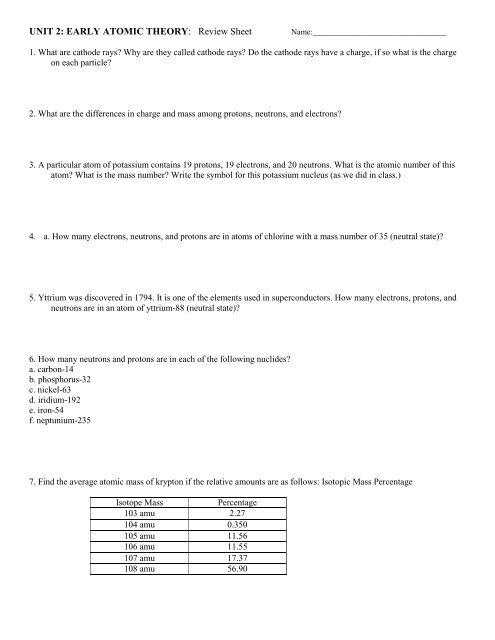
Structure of atoms worksheet
› worksheets › atomicAtomic Structure Worksheet - Basic Electricity Most carbon atoms contain 6 neutrons, but some may contain more or less than 6. Each atom of hydrogen is guaranteed to contain 1 proton. Unless the atom is electrically charged, it will contain 1 electron as well to balance the charge of the one proton. Most hydrogen atoms contain no neutrons, but some contain either one or two neutrons. Chemistry - Wikipedia Chemistry is the scientific study of the properties and behavior of matter. It is a natural science that covers the elements that make up matter to the compounds composed of atoms, molecules and ions: their composition, structure, properties, behavior and the changes they undergo during a reaction with other substances.. In the scope of its subject, chemistry occupies an … › science › answerAtomic Structure Worksheets - Easy Teacher Worksheets All atoms have the same number of protons and electrons, and most atoms have the same number of protons and neutrons. The significance of atoms is that without them, nothing could exist. They are the building blocks of all chemical structures. When atoms combine, they create individual compounds that are part of the universe. The Four Most ...
Structure of atoms worksheet. Atomic Structure Worksheet - WILLAMETTE LEADERSHIP … Atomic Structure Worksheet. Label the parts of an atom on the diagram below. 4. What type of charge does a proton have? 5. What type of charge does a neutron have? 6. What type of charge does an electron have? 7. Which two subatomic particles are located in the nucleus of an atom? 8. If an atom has 35 protons in the nucleus, how many electrons ... Atomic Structure Worksheets - Easy Teacher Worksheets When atoms combine, they create individual compounds that are part of the universe. The Four Most Common Atoms. The four most common atoms are nitrogen, oxygen, carbon, and hydrogen. In all, there are over one hundred discovered atoms. Let’s learn some interesting facts about these common atoms and how they impact the world around us. › cms › lib6Basic Atomic Structure Worksheet Key - Neshaminy School District Basic Atomic Structure Worksheet and the 1. 2. 3. 4. 5. 6. 8. 9. The 3 particles of the atom are: Their respective charges are: The number of protons in one atom of ... Ionic Bonding | PBS LearningMedia This interactive activity from ChemThink discusses ionic bonding—a type of chemical bond formed between two ions with opposite charges. Investigate how the transfer of electrons between atoms creates ions and how the mutual attraction of these charged particles forms ionic bonds. Also learn about trends in the periodic table of elements, and explore how the structure of an …
Achiever Papers - We help students improve their academic standing All our academic papers are written from scratch. All our clients are privileged to have all their academic papers written from scratch. These papers are also written according to your lecturer’s instructions and thus minimizing any chances of plagiarism. Chemistry of Matter - Science Spot Part A: Atomic Structure 1. Draw five protons in the nucleus of the atom. Label them with their charge. 2. Draw six neutrons in the nucleus of the atom. 3. Draw two electrons in the first energy level and label them with their charge. 4. Draw three electrons in the second energy level and label them with their charge. 5. What element is ... en.wikipedia.org › wiki › Molecular_Structure_ofMolecular Structure of Nucleic Acids: A Structure for ... In 1951, Pauling published the structure of the alpha helix, a fundamentally important structural component of proteins. In early 1953, Pauling published a triple helix model of DNA, which subsequently turned out to be incorrect. Both Crick, and particularly Watson, thought that they were racing against Pauling to discover the structure of DNA. › cms › libAtomic Structure Worksheet - Washoe County School District The of an element is the average mass of an element’s naturally occurring atoms, or isotopes, taking into account the of each isotope. The of an element is the total number of protons and neutrons in the of the atom. The mass number is used to calculate the number of in one atom of an element.
sciencespot.net › Media › AtomicBasicsChemistry of Matter - Science Spot Part A: Atomic Structure 1. Draw five protons in the nucleus of the atom. Label them with their charge. 2. Draw six neutrons in the nucleus of the atom. 3. Draw two electrons in the first energy level and label them with their charge. 4. Draw three electrons in the second energy level and label them with their charge. 5. Molecular Structure of Nucleic Acids: A Structure for … "Molecular Structure of Nucleic Acids: A Structure for Deoxyribose Nucleic Acid" was the first article published to describe the discovery of the double helix structure of DNA, using X-ray diffraction and the mathematics of a helix transform. It was published by Francis Crick and James D. Watson in the scientific journal Nature on pages 737–738 of its 171st volume (dated 25 April … Build an Atom - Atoms | Atomic Structure | Isotope Symbols Build an atom out of protons, neutrons, and electrons, and see how the element, charge, and mass change. Then play a game to test your ideas! › science › answerAtomic Structure Worksheets - Easy Teacher Worksheets All atoms have the same number of protons and electrons, and most atoms have the same number of protons and neutrons. The significance of atoms is that without them, nothing could exist. They are the building blocks of all chemical structures. When atoms combine, they create individual compounds that are part of the universe. The Four Most ...
Chemistry - Wikipedia Chemistry is the scientific study of the properties and behavior of matter. It is a natural science that covers the elements that make up matter to the compounds composed of atoms, molecules and ions: their composition, structure, properties, behavior and the changes they undergo during a reaction with other substances.. In the scope of its subject, chemistry occupies an …
› worksheets › atomicAtomic Structure Worksheet - Basic Electricity Most carbon atoms contain 6 neutrons, but some may contain more or less than 6. Each atom of hydrogen is guaranteed to contain 1 proton. Unless the atom is electrically charged, it will contain 1 electron as well to balance the charge of the one proton. Most hydrogen atoms contain no neutrons, but some contain either one or two neutrons.




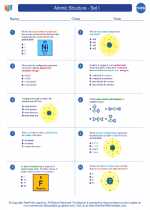
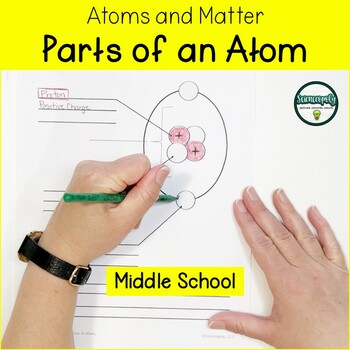





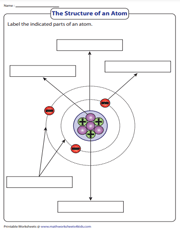
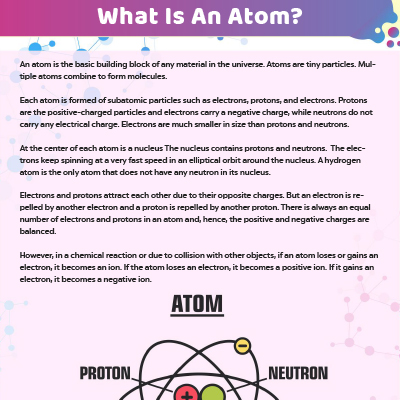


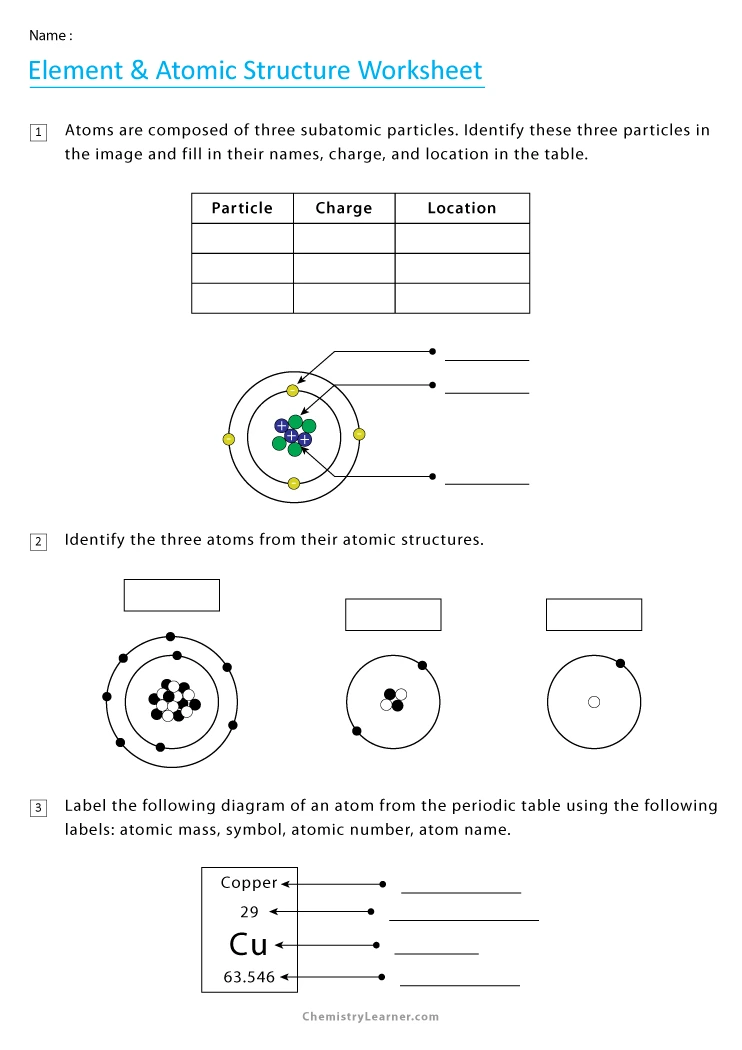
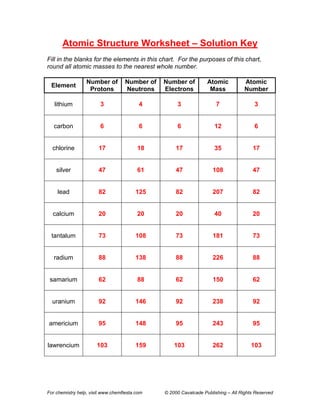
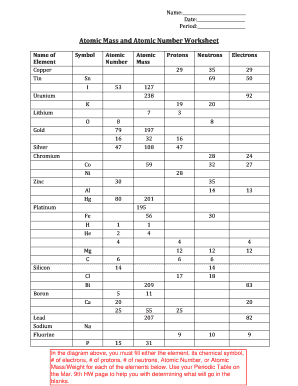

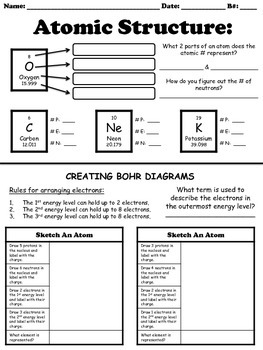


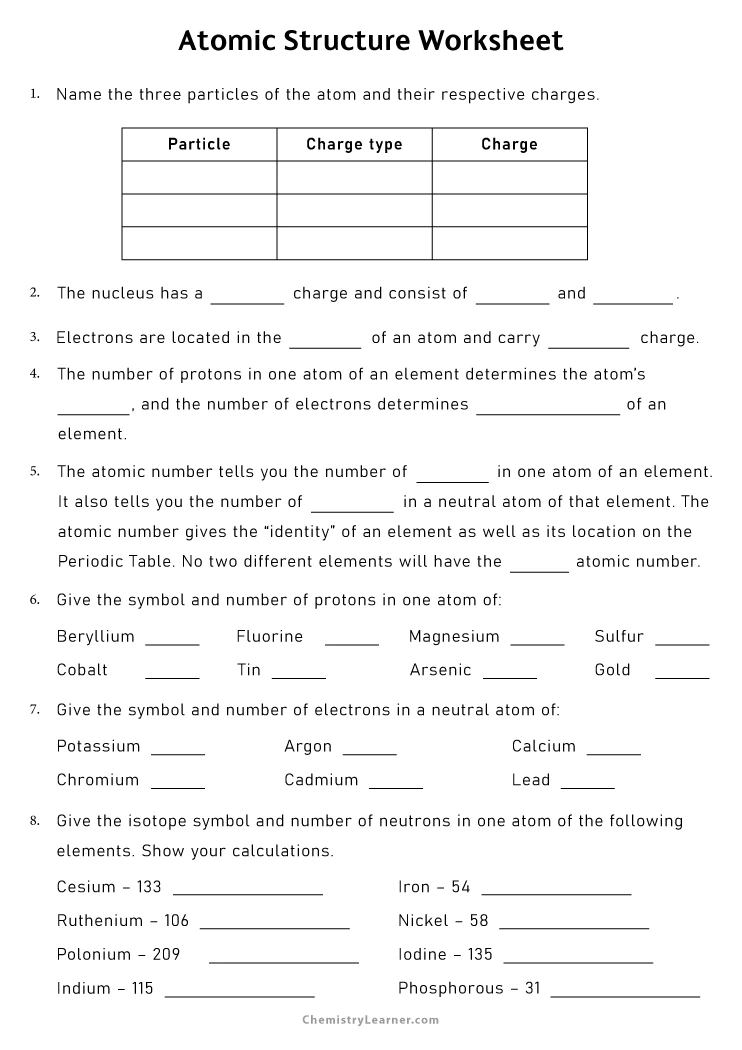
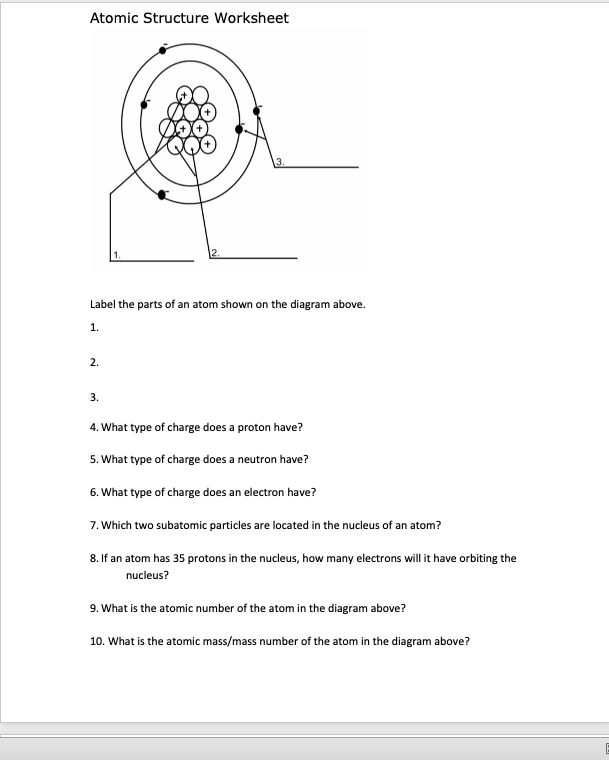
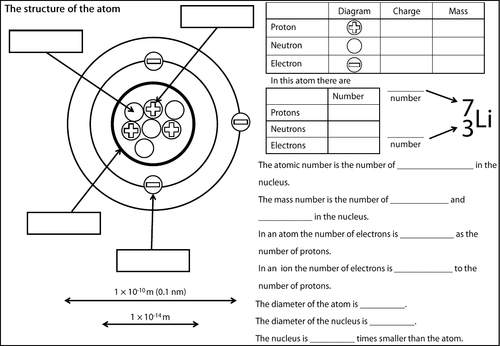

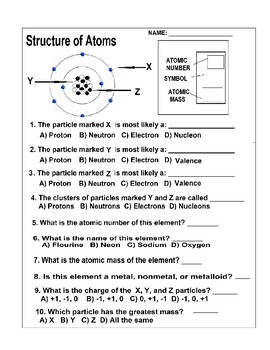





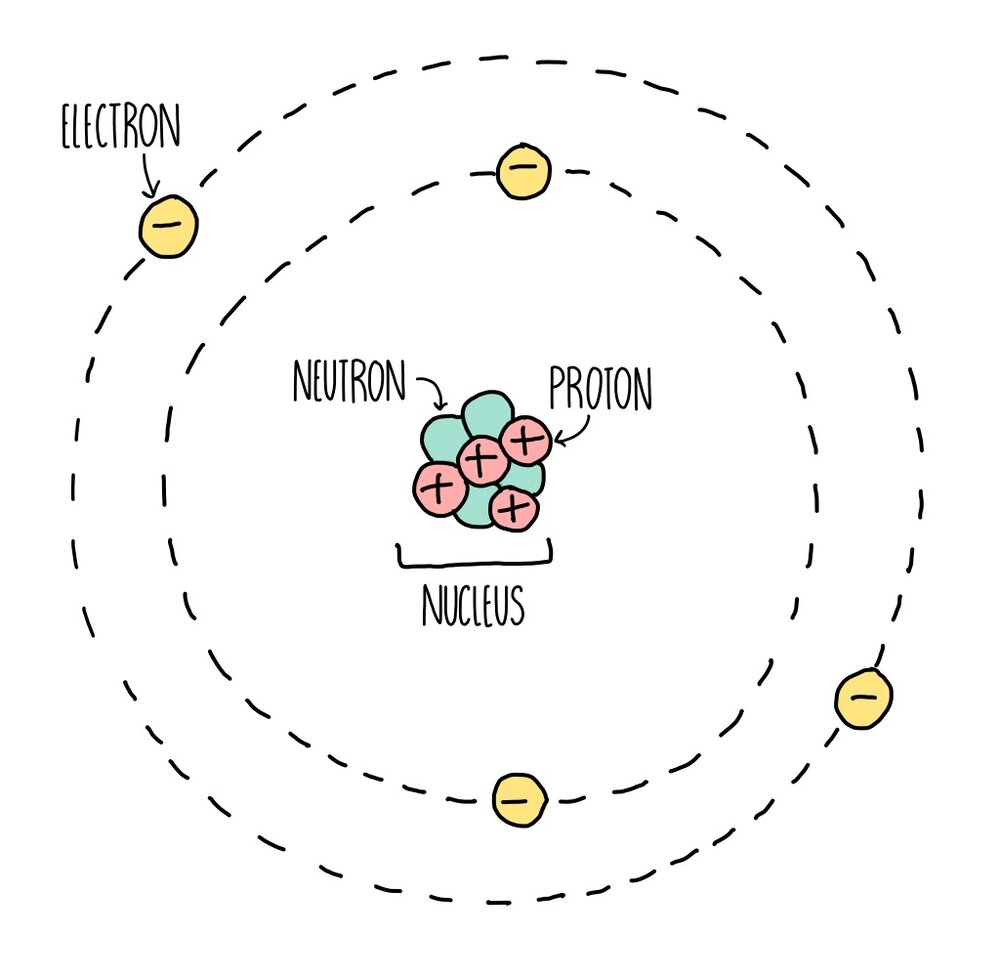
0 Response to "38 structure of atoms worksheet"
Post a Comment